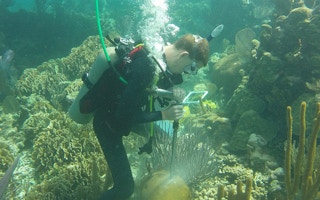Global warming may have started far earlier than anyone has so far imagined. The first signs of climate change driven by rising levels of atmospheric carbon dioxide may have been there in the year the world’s first intercity railway link opened between Manchester and Liverpool, when the Duke of Wellington was still Prime Minister of Britain, when an angry Parisian mob overturned the French monarchy in 1830.
But if so – and climate scientists and modellers will argue whether in fact humans sparked warming so early – the evidence is available only with benefit of a long time series and twenty-twenty hindsight.
Nerilie Abram, climate scientist at the Australian National University, and international colleagues in the Past Global Changes consortium known as PAGES report in the journal Nature that they looked once again at all the climate data – records and proxy evidence from ice cores and ocean sediments – since 1500 AD.
What they saw there was that the sustained trend of warming in the 20th century may have shown its first signs in the tropical oceans and over some parts of the land surfaces of the Northern Hemisphere as early as the 1830s.
“
It was one of those moments where science really surprised us. But the results were clear. What we are witnessing today started about 180 years ago.
Nerilie Abram, climate scientist, Australian National University
Before the first novels of Charles Dickens, before Queen Victoria, there may have been the first signs of anthropogenic warming. This is earlier than anybody expected, including the scientists who have just published the research.
Surprise
“It was an extraordinary finding,” said Dr Abram. “It was one of those moments where science really surprised us. But the results were clear. What we are witnessing today started about 180 years ago.”
Corals, like trees, have annual growth rings, and these too can tell a story of climate change. By bringing together coral measurements and evidence from sea floor sediments, the scientists recorded a steady turn for the warmer in ocean temperatures early in the 19th century.
“Somebody living in the 1830s or even the 1890s would not have been able to distinguish that there was this change afoot,” she said. “It’s by having this long record now that extends almost 200 years from that point that we can go back and say ‘Well, this was when the changes first started.’”
The observation had to be backed up by computer simulation: the very early 19th century had been marked by catastrophic volcanic eruptions, one of which – Mount Tambora in Indonesia in 1815 – led to the notorious “Year without a Summer”.
That followed in 1816, when the poets Byron, Shelley and Mary Shelley and young Dr Polidori shivered away in a villa in Geneva, and left the world the legacy of Frankenstein and the first vampire novel.
Theoretically, the warming could have been a response to the recovery after the eruptions. But, said Nicholas McKay, a climate scientist at Northern Arizona University, and one of the authors, this is not the case.
“If you run the models with only volcanoes and no increase in greenhouse gases, you see a warming, starting in the early 1800s. But then it levels off, and you don’t see that warming continue through the 20th century,” he said.
But once the increases in greenhouse gases were incorporated, the globe started warming around 1830 and carried on warming, just as the coral records showed.
“In some ways it is really a positive message, because it suggests that the climate system can respond very quickly to relatively small changes in greenhouse gases,” he said.
“It means that our actions as a society, both positive and negative, can result in an immediate impact.”
This story was published with permission from Climate News Network.

















